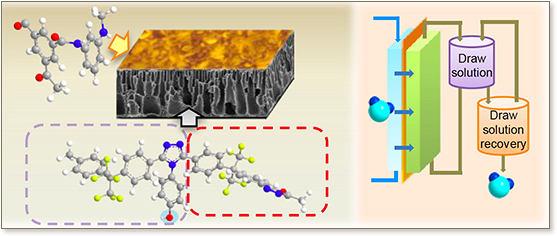Hydroxyl functionalized polytriazole-co-polyoxadiazole as substrates for forward osmosis membranes
P.H.H. Duong, S. Chisca, P.-Y. Hong, H. Cheng, S.P. Nunes, T.-S. Chung
ACS Applied Materials and Interfaces, 7 (7), pp. 3960-3973, (2015)

Hydroxyl functionalized polytriazole-co-polyoxadiazole (PTA–POD) copolymers have been synthesized and cast as promising highly thermally stable, chemically resistant, and antiorganic/biological fouling porous substrates for the fabrication of thin-film composite (TFC) forward osmosis (FO) membranes. The roles of PTA/POD ratios in the membrane substrates, TFC layers, and FO membrane performance have been investigated. This study demonstrates that the substrate fabricated from the copolymer containing 40 mol % PTA is optimal for the TFC membranes. Compared to the POD–TFC membrane, the 40 mol % PTA–TFC membrane exhibits a remarkable decrease in structural parameter (S) of more than 3.3 times. In addition, the 40 mol % PTA–TFC membrane is characterized by high water fluxes of 24.9 LMH and 47.2 LMH using 1 M NaCl as the draw solution and DI water as the feed under FO and pressure retarded osmosis (PRO) modes, respectively. Compared to a polysulfone (PSU) supported TFC-FO membrane under similar fabrication conditions, the 40% mol PTA–TFC membrane shows better FO performance and enhanced antifouling properties on the support (lower protein binding propensity and improved bacterial inhibition). Moreover, the performance of the 40 mol % PTA supported TFC-FO membrane can be improved to 37.5 LMH (FO mode)/78.4 LMH (PRO mode) and potentially higher by optimizing the support morphology, the TFC formation, and the post-treatment process. Hence, the use of newly developed hydroxyl functionalized polytriazole-co-polyoxadiazole copolymers may open up a new class of material for FO processes.